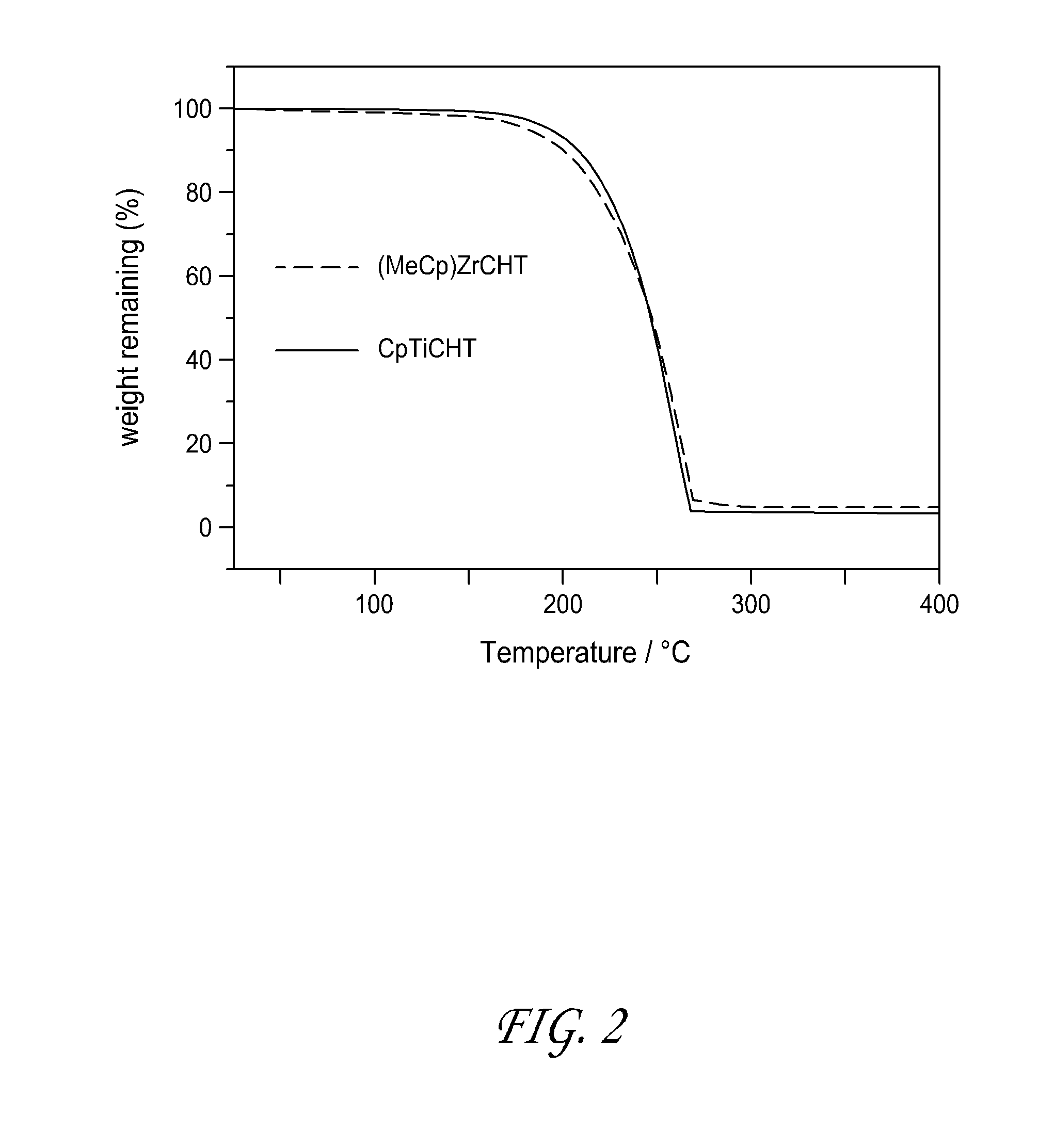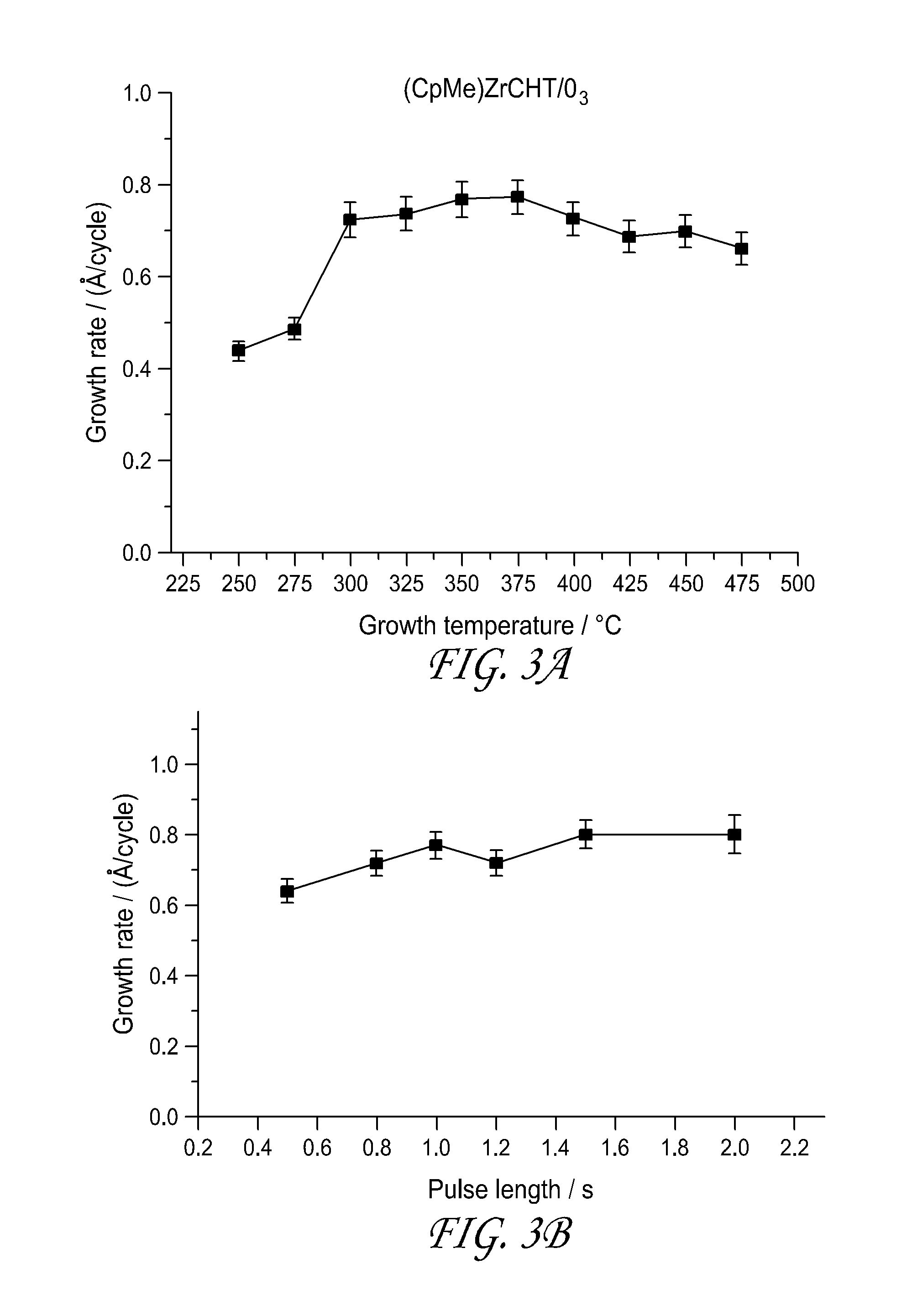Precursors and methods for atomic layer deposition of transition metal oxides
a technology of transition metal oxide and precursors, which is applied in the direction of zirconium oxides, organic chemistry, coatings, etc., can solve the problems of reducing the decomposition rate of some precursors, and still more or less self-saturating reactions
- Summary
- Abstract
- Description
- Claims
- Application Information
AI Technical Summary
Benefits of technology
Problems solved by technology
Method used
Image
Examples
example 1
[0108]Synthesis of (C5H5)Ti(C7H7): The synthesis was done using the method of Demerseman et al. (Inorg. Chem. 1982, 21, 3942.). CpTiCl3 had to be synthesized initially and two different methods were employed synthesizing different batches. First the method of Sloan at al. (J. Am. Chem. Soc. 1959, 81, 1364.) was employed. The method of Hitchcock et al. (Dalton Trans., 1999, 1161.) was also used as Cp2TiCl2 is readily available.
[0109]In a 1-L flask containing 20 g of magnesium chips were added 2 g of anhydrous FeCl3, 50 ml of cycloheptatriene, 50 ml of THF, and, over a 3-h period to allow the warming of the stirred reaction mixture, a solution of 57.45 g (0.26 mol) of CpTiCI3 in 400 ml of THF. The mixture was stirred at room temperature over night and the volatile products were evaporated under vacuum. Sublimation of the residue (130° C. / 0.05 mmHg) gave a blue solid: 85.8% yield (45.9 g); 1H NMR (C6D6):), 4.91 (s, 5H, CH), 5.43 (s, 7H, CH); 13C{1H} NMR (C6D6): 97.35 (CH, C7-ring), 86....
example 2
[0111]Synthesis of (MeC5H4)Zr(C7H7): The synthesis was performed in a fashion similar to that described for CpZrCHT by Tamm et al. (Organometallics 2005, 3163.). The method is also similar with that presented for CpTiCHT in Example 1 above. MeCpZrCl3 needed in the synthesis was synthesized using the method of Hitchcock et al. (Polyhedron 1995, 14, 2745.). A Schlenk flask was charged with magnesium turnings (6 g, 247 mmol), catalytic amounts of ferric chloride (0.6 g, 3.7 mmol), cycloheptatriene (15 ml), and THF (50 ml). This reaction mixture was treated dropwise with a solution of MeCpZrCl3 (17.3 g, 62.4 mmol) in THF (150 ml) over a period of 1 h. After the mixture was stirred overnight at room temperature, all volatiles were removed in vacuo. The air-sensitive residue was sublimed at 140° C. / 0.05 mbar to obtain 13.0 g (79.6%) of (MeC5H4)Zr(C7H7) as a purple crystalline solid. Anal. calcd. for Zr1C13H14: C: 33.65; H: 6.35. Found: C: 26.963; H: 5.03. Mp. 174-176° C., 1H NMR (C6D6) 1....
example 3
[0113]The thermal stability of the CpTiCHT synthesized in Example 1 was tested on an extremely high surface area silica substrate and found to be good. The compound saturated the silica surface at 400° C., although the ligands are most likely decomposed. CpTiCHT was observed to be a blue solid that vaporized at 130° C.
PUM
| Property | Measurement | Unit |
|---|---|---|
| temperature | aaaaa | aaaaa |
| temperature | aaaaa | aaaaa |
| thickness | aaaaa | aaaaa |
Abstract
Description
Claims
Application Information
 Login to View More
Login to View More - R&D
- Intellectual Property
- Life Sciences
- Materials
- Tech Scout
- Unparalleled Data Quality
- Higher Quality Content
- 60% Fewer Hallucinations
Browse by: Latest US Patents, China's latest patents, Technical Efficacy Thesaurus, Application Domain, Technology Topic, Popular Technical Reports.
© 2025 PatSnap. All rights reserved.Legal|Privacy policy|Modern Slavery Act Transparency Statement|Sitemap|About US| Contact US: help@patsnap.com



